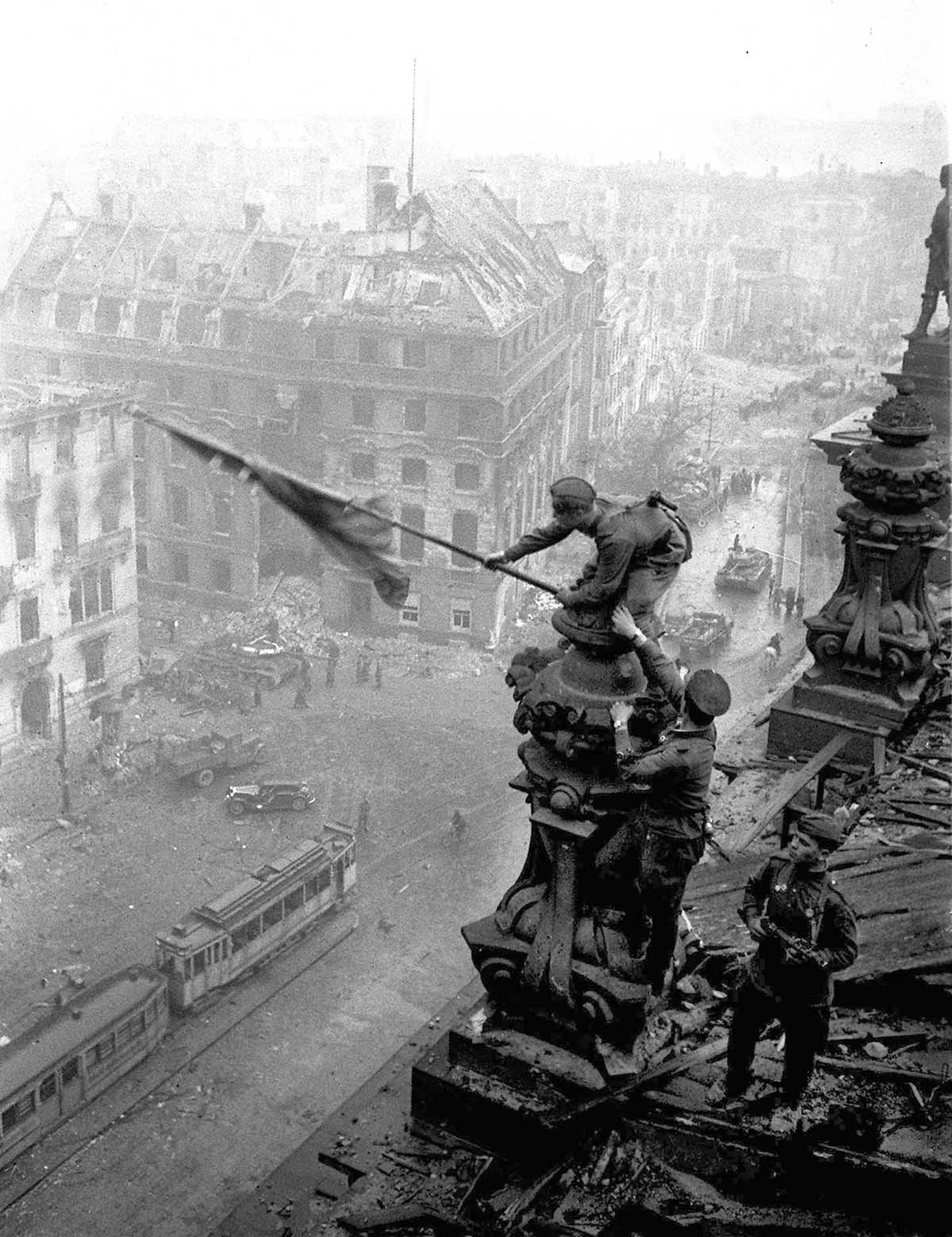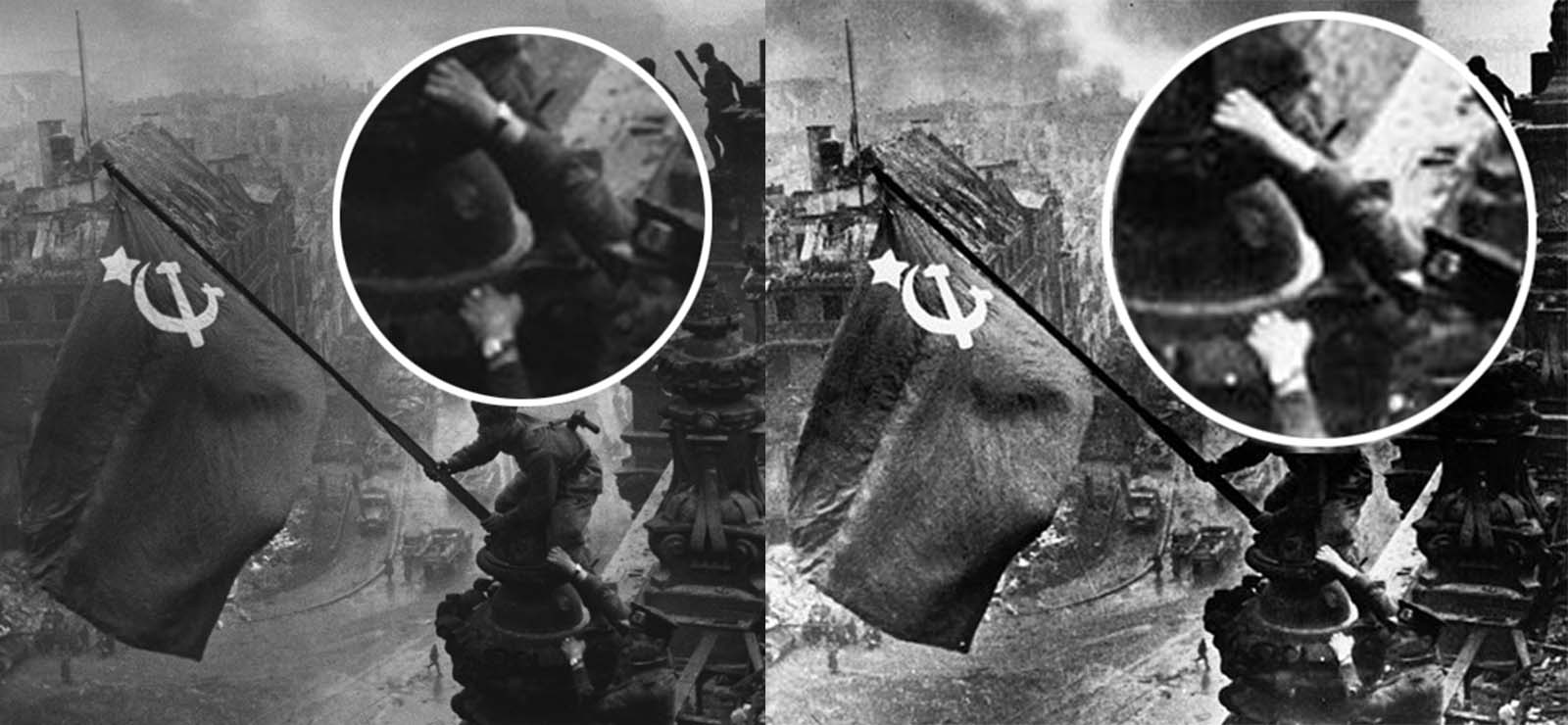
Soldiers raising the Soviet flag over the Reichstag, 1945.
The “Soviet flag over Reichstag” photograph is full of symbolism and represents a historic moment. Erected in 1894, the Reichstag’s architecture was magnificent for its time.
The building contributed much to German history and was considered by the Red Army the symbol of their enemy. Soviets finally captured the Reichstag on 2 May 1945.
Next to Joe Rosenthal’s photo of raising the flag on Iwo Jima, Yevgeny Khaldei’s photo of Soviet soldiers raising a flag on top of the Reichstag building in Berlin is perhaps the most famous photo of World War II. But unlike the Iwo Jima photo, Khaldei’s Reichstag photo was both staged and doctored.
Khaldei’s photo was directly inspired by Rosenthal’s Iwo Jima photo. Noting the publicity the Iwo Jima photo had received, Soviet officials (perhaps Stalin himself) ordered Khaldei to fly from Moscow to Berlin in order to take a similar photo that would symbolize the Soviet victory over Germany. Khaldei carried with him a large flag, sewn from three tablecloths for this very purpose, by his uncle.
When Khaldei arrived in Berlin, he considered a number of settings for the photo, including the Brandenburg Gate and Tempelhof Airport, but he decided on the Reichstag, even though Soviet soldiers had already succeeded in raising a flag over this building a few days earlier. Khaldei recruited a small group of soldiers and, on May 2, 1945, proceeded to recreate the scene.

Khaldei took a Soviet flag with him in his luggage.

Soviet censors who examined the photo noticed that one of the soldiers had a wristwatch on each arm, indicating he had been looting.
Back in Moscow, Soviet censors who examined the photo noticed that one of the soldiers had a wristwatch on each arm, indicating he had been looting. They did not want to impose that image on their country.
They asked Khaldei to remove one of the watches. Khaldei not only did so but also darkened the smoke in the background. The resulting picture was published soon after in the magazine Ogonjok. It became the version that achieved worldwide fame.

The original picture published on Ogonjok.
Later some Soviet sources claimed that the extra wrist watches were actually Adrianov compasses and that the Soviet Army touched out of the picture because they knew that this would be mistaken as a watch acquired by looting corpse rather than a piece of standard equipment.
The Adrianov compass was a military compass designed by Russian Imperial Army topographist Vladimir Adrianov in 1907. Wrist-worn versions of the compass were then adopted and widely used by the Red and Soviet Army.

The original photo (left) was altered (right) by editing the watch on the soldier’s right wrist.
Subsequently, the photo continued to be altered. The flag was made to appear to be billowing more dramatically in the wind. The photo was also colorized.
Throughout his life, Khaldei remained unrepentant about having manipulated his most famous photograph. Whenever asked about it, he responded: “It is a good photograph and historically significant. Next question please”.
German magazine Der Spiegel wrote: “Khaldei saw himself as a propagandist for a just cause, the war against Hitler and the German invaders of his homeland.
In the years before his death in October 1997, he liked to say: ‘I forgive the Germans, but I cannot forget’. His father and three of his four sisters were murdered by the Germans”.
(Photo credit: Yevgeny Khaldei / Russsian Archives).